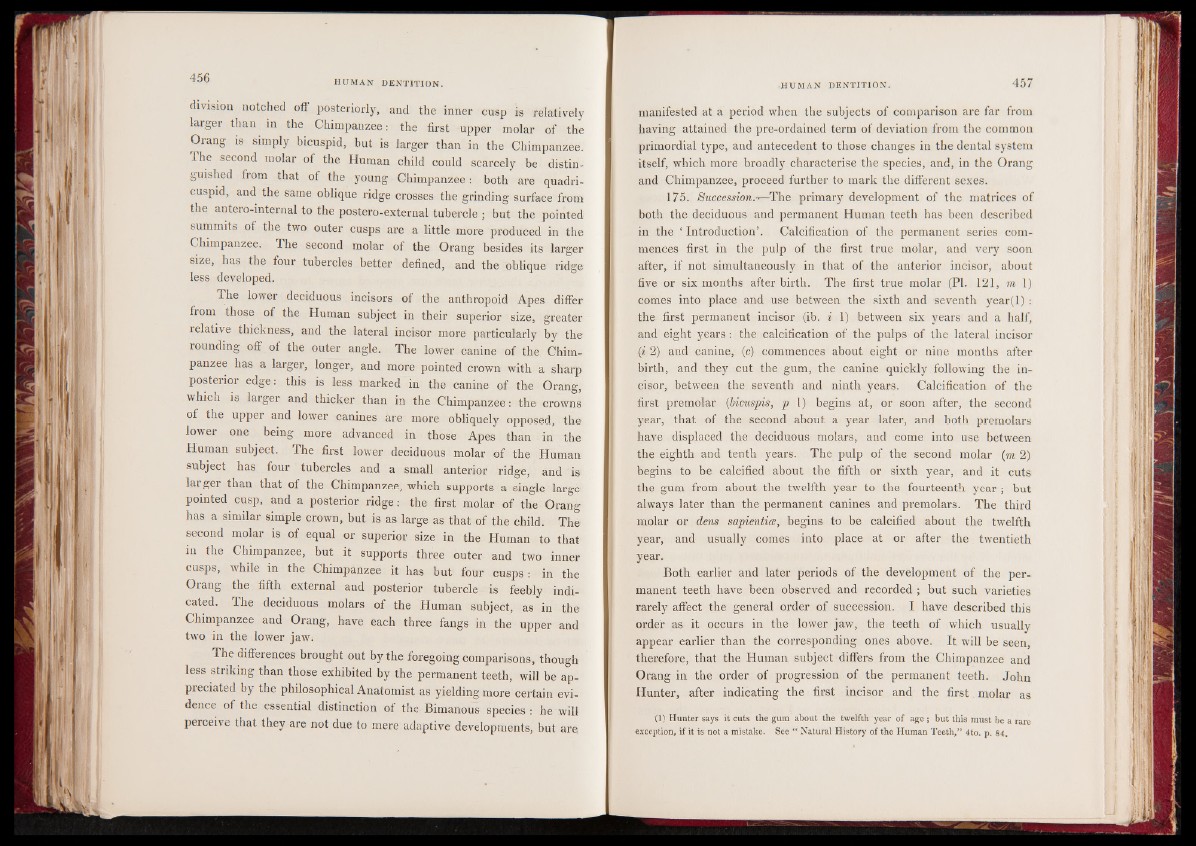
division notched off posteriorly, and the inner cusp is relatively
larger than in the Chimpanzee: the first upper molar of the
Orang is simply bicuspid, but is larger than in the Chimpanzee.
The second molar of the Human child could scarcely be distinguished
from that of the young Chimpanzee: both are quadri-
cuspid, and the same oblique ridge crosses the grinding surface from
the antero-internal to the postero-external tubercle | but the pointed
summits of the two outer cusps are a little more produced in the
Chimpanzee. The second molar of the Orang besides its larger
size, has the four tubercles better defined, and the oblique ridge
less developed.
The lower deciduous incisors of the anthropoid Apes differ
from those of the Human subject in their superior size, greater
relative thickness, and the lateral incisor more particularly by the
rounding off of the outer angle. The lower canine of the Chimpanzee
has a larger, longer, and more pointed crown with a sharp
posterior edge: this is less marked in the canine of the Orang,
which is larger and thicker than in the Chimpanzee: the crowns
of the upper and lower canines are more obliquely opposed, the
lower one being more advanced in those Apes than in the
Human subject. The first lower deciduous molar of the Human
subject has four tubercles and a small anterior ridge, and is
larger than that of the Chimpanzee, which supports a single large
pointed cusp, and a posterior ridge: the first molar of the Orang
has a similar simple crown, hut is as large as that of the child. The
second molar is of equal or superior size in the Human to that
in the Chimpanzee, but it supports three outer and two inner
cusps, while in the Chimpanzee it has but four cusps : in the
Orang the fifth external and posterior tubercle is feebly indicated.
The deciduous molars of the Human subject, as in the
Chimpanzee and Orang, have each three fangs in the upper and
two in the lower jaWi
The differences brought out by the foregoing comparisons, though
less striking than those exhibited by the permanent teeth, will be appreciated
by the philosophical Anatomist as yielding more certain evidence
of the essential distinction of the Bimanous species : he will
perceive that they are not due to mere adaptive developments, but are
manifested at a period when the subjects of comparison are far from
having attained the pre-ordained term of deviation from the common
primordial type, and antecedent to those changes in the dental system
itself, which more broadly characterise the species, and, in the Orang
and Chimpanzee, proceed further to mark the different sexes.
175. Succession.-^-'The primary development of the matrices of
both the deciduous and permanent Human teeth has been described
in the ‘Introduction’. Calcification of the permanent series commences
first in the pulp of the first true molar, and very soon
after, if not simultaneously in that of the anterior incisor, about
five or six months after birth. The first true molar (PI. 121, m 1)
comes into place and use between the sixth and seventh year(l) :
the first permanent incisor y(ib. i 1) between six years and a half,
and eight years: the calcification of the pulps of the lateral incisor
(i 2) and canine, (c) commences about eight or nine months after
birth, and they cut the gum, the canine quickly following the incisor,
between the seventh and ninth years. Calcification of the
first premolar jjbicuspis, p 1) begins at, or soon after, the second
year, that of the second about a year later, and both premolars
have displaced the deciduous molars, and come into use between
the eighth and tenth years. The pulp of the second molar (m 2)
begins to be calcified about the fifth or sixth year, and it cuts
the gum from about the twelfth year to the fourteenth year ; but
always later than the permanent canines and premolars. The third
molar or dens sapiential, begins to be calcified about the twelfth
year, and usually comes into place at or after the twentieth
year.
Both earlier and later periods of the development of the permanent
teeth have been observed and recorded ; but such varieties
rarely affect the general order of succession. I have described this
order as it occurs in the lower jaw, the teeth of which usually
appear earlier than the corresponding ones above. It will be seen,
therefore, that the Human subject differs from the Chimpanzee and
Orang in the order of progression of the permanent teeth. John
Hunter, after indicating the first incisor and the first. molar as
(1) Hunter says it cuts the gum about the twelfth year of age ; but this must be a rare
exception, if it is not a mistake. See “ Natural History of the Human Teeth,” 4to. p. 84.